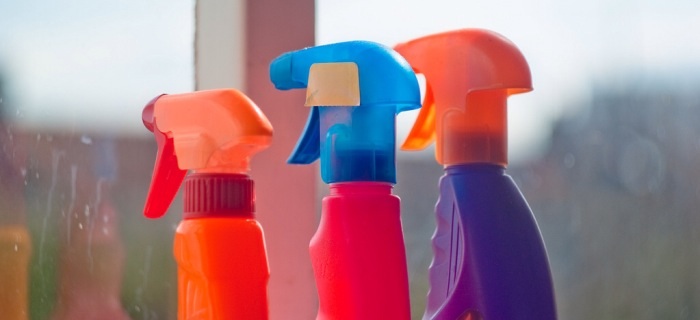Household Cleaners: The 3 Worst Poisons Under the Sink

Did you know the air inside most American homes is worse than the air outside? The Environmental Protection Agency estimates that indoor air pollutants may be 2 to 5 times higher than out of doors, and in some homes are as much as 100 times higher! What's more, 90% of all poisonings are a result of household toxins.

The problem is the collection of cleaners under the average sink. Many cleaners give off volatile organic compounds (VOCs). Even when you keep bottles firmly closed and stored, the cleaners can often still exude VOCs into the air--fumes you and your children are breathing. VOCs have been implicated in everything from asthma and other respiratory problems to cancer. Children are at greatest risk, since they're both smaller than adults and are still growing.
And that's not the only problem these chemicals can cause. Here is a rundown of some of the worst chemicals in common household cleaners and what you can use instead.
Ammonia
Ammonia is often found in all-purpose household cleaners. It's a very effective degreaser and glass cleaner.
Unfortunately, its fumes are also highly irritating. Ammonia can cause severe eye irritation, headaches and lung damage. It's also extremely poisonous to fish and other aquatic life, even in dilute amounts. That means that any ammonia you put down the drain is poisoning the water around you.
Ammonia poses an even greater danger when combined with other household chemicals. Combining ammonia and bleach, for example, creates ammonia gas, which can be fatal if breathed in. If you insist on using ammonia, only use it diluted with water. NEVER mix ANYTHING else with ammonia!
The best substitute for ammonia as a window cleaner is vinegar and water. As a degreaser, washing soda is a terrific less-toxic substitute that will even strip floor wax.
Chloride Bleach
Chloride bleach is very strongly corrosive. Its fumes alone can irritate or burn skin, eyes and lungs. If it's swallowed, it can cause vomiting or pulmonary edema--the filling of the lungs with fluid. Needless to say, don't store bleach near ammonia. Not only that, don't mix bleach with vinegar. It can trigger the release of toxic gas.
Bleach is found all on its own, and in caustic drain cleaners. That's why you should NEVER NEVER NEVER use anything else in conjunction with a drain cleaner, or mix drain cleaners. If you use a drain cleaner, don't follow up with a different one for at least 24 hours.
Bleach does have a limited place in some households. If there is a person with a blood-borne communicable disease in your house, like HIV, very dilute bleach may be your best and safest bet for keeping others from becoming infected if there is a blood spill.
The best substitute for chloride bleach in the laundry is an oxygen bleach like Oxyclean, to name a brand. Don't assume that anything with "oxy" in the name is an oxygen bleach; read the labels. For disinfecting, nothing beats plain old boiling water. Nothing lives through that!
Formaldehyde
Formaldehyde is a known carcinogen. You know that weird smell new office carpet has? That's off-gassing, and what you're breathing in probably contains formaldehyde. Formaldehyde fumes can also trigger asthma attacks, headaches, and skin and eye irritation.
In the home, formaldehyde is found as a preservative in air fresheners, spray starch, shampoos, deodorants and many other products. The problem is, it's not always listed as an ingredient. And sometimes it's listed as part of another ingredient or can contaminate another ingredient, like the sodium laureth sulfate commonly used in shampoos.
The best advice for avoiding formaldehyde is, if you can't pronounce an ingredient, don't buy the product. Essential oil diffusers can be used instead of air fresheners, non-SLS shampoos are now commonly found (Dr. Bronner's castile soap makes fine shampoo, for instance, and is so useful around the house), and so are natural deodorants.
Disposing of household chemicals
So now I've got you looking at those multi-hued bottles under the sink with a jaundiced eye. Let's get rid of them! you say. Great! But don't just toss them in the trash.
Contact your local disposal company or government agency. Many of them have special toxin disposal days where you can bring your household chemicals and dispose of them safely. If you dispose of your own trash, NEVER burn used household cleaner containers, and don't bury half-used containers of stuff. Contact the manufacturer for safe disposal methods.
Lynn Siprelle cracks that whip round these parts.
